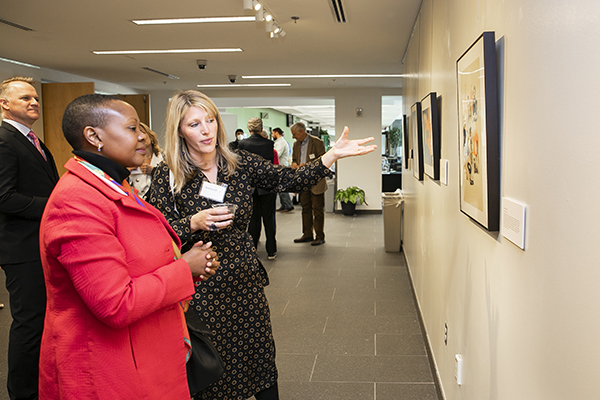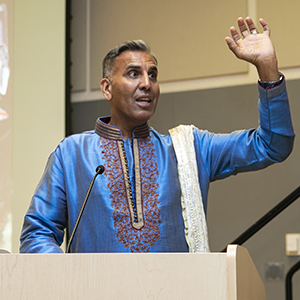In This Story


Reprinted with permission from the Pioneers Post (UK).
When Professor J.P. Singh heard the British Council’s plan, he wasn’t entirely convinced.
“I didn’t know what to expect,” said the professor of global commerce and policy at the Schar School of Policy and Government at George Mason University.
The British Council, the U.K.’s international organization for cultural relations and educational opportunities, had commissioned 12 artists to illustrate his paper that outlined a theoretical framework for cultural relations approaches to international development. “Although it’s about art, and I work in that area,” said Singh, “I’ve just never had artists interpret a very academic paper.”
An exhibit of the commissioned art opened in April at the Van Metre Hall Art Gallery at Mason Square, formerly Arlington Campus, in Arlington, Virginia. In addition to a panel discussion about art, culture, and global commerce, Elsie S. Kanza, ambassador of Tanzania to the U.S. and Mexico, delivered a keynote speech. The exhibit continues until May 13.
Like Singh, Kazz Morohashi was similarly hesitant when faced with turning the paper into art. “It was a little difficult to get my head around it. Initially, I had to read it a couple of times,” said the artist who is finishing her PhD in museum learning design at the Norwich University of the Arts in England.
But after a period of nine months working with Singh and the other artists, the Japanese-born, U.K.-based creative produced a work which somehow manages to distill some of the ethics and practices of new approaches to development work into a two-and-a-half-minute animated video about a toy rabbit and his floristry business.
The paper and art are the result of Developing Inclusive and Creative Economies (DICE), a three-year pilot program designed to foster cultural and economic agency launched in 2018.
